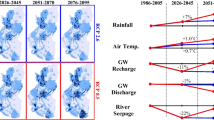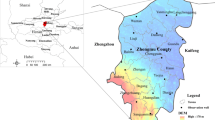Abstract
Groundwater plays a critical supporting role in agricultural production in the California Central Valley (CV). Recent prolonged droughts (notably 2007–2009 and 2012–2016) caused dramatic depletion of groundwater, indicating the susceptibility of the CV’s water supply to climate change. To assess the impact of climate change on groundwater storage in the CV, we combined integrated surface water and groundwater models with climate projections from 20 global climate models and thereby explore the vulnerability of CV groundwater under two climate scenarios RCP4.5 and RCP8.5. We found that groundwater has been declining over the past decades (3 km3/year on average during 1950–2009). In the absence of future mitigating measures, this decline will continue, but at a higher rate due to climate change (31% and 39% increase in loss rate under RCP4.5 and RCP8.5). The greatest loss (more than 80% of the total) will occur in the semi-arid southern Tulare region. We performed computational experiments to quantify the relative contribution of future crop water use and headwater inflows to total groundwater storage change. Our results show that, without management changes, continuing declines in future groundwater storage will mainly be attributable to ongoing overuse of groundwater. However, future changes in the seasonality of streamflow into the CV, (small) changes in annual inflows, and increased crop water use in a warmer climate will lead to 40–70% more annual groundwater losses than the current annual average, up to approximately 5 km3/year.







Similar content being viewed by others
Change history
23 March 2021
Incorrect ORCID ID for second author has been removed.
References
Alam S, Gebremichael M, Li R (2019) Remote sensing-based assessment of the crop, energy and water Nexus in the Central Valley, California. Remote Sens 11(14):1701
Allen RG, Pereira LS, Raes D, Smith M (1998) FAO irrigation and drainage paper no. 56. Food and Agriculture Organization of the United Nations, 56(97), Rome, p e156
Bales RC, Molotch NP, Painter TH, Dettinger MD, Rice R, Dozier J (2006) Mountain hydrology of the western United States. Water Resour Res 42(8)
Brush CF, Belitz K, Phillips SP (2004) Estimation of a water budget for 1972–2000 for the grasslands area, central part of the Western San Joaquin Valley, California. US Department of the Interior, US Geological Survey
Brush CF and Dogrul EC (2013) User’s manual for the California Central Valley groundwater-surface water simulation model (C2VSim), version 3.02-CG. Bay-Delta Office, California Department of Water Resources
Brush CF, Dogrul EC, Kadir TN (2013) Development and calibration of the California Central Valley groundwater-surface water simulation model (C2VSim), version 3.02-CG. Bay-Delta office, California Department of Water Resources
Cal-Adapt (2018). Cal-Adapt is developed by the Geospatial Innovation Facility at University of California, Berkeley. Data downloaded from https://cal-adapt.org/ Accessed Nov. 2018
California State Legislature (2014) Sustainable groundwater management act. Accessed April 12, 2018. https://www.opr.ca.gov/docs/2014_Sustainable_Groundwater_Management_ Legislation_092914.pdf
CDWR (2016) Estimates of natural and unimpaired flows for the Central Valley of California: water years 1922–2014. Report from California Department of Water Resources
Cooper MG, Schaperow JR, Cooley SW, Alam S, Smith LC, Lettenmaier DP (2018) Climate elasticity of low flows in the maritime western US mountains. Water Resour Res 54(8):5602–5619
Dale LL, Dogrul EC, Brush CF, Kadir TN, Chung FI, Miller NL, Vicuna SD (2013) Simulating the impact of drought on California’s Central Valley hydrology, groundwater and cropping. Int J Environ Climate Change 3(3):271–291
Famiglietti JS (2014) The global groundwater crisis. Nat Clim Chang 4(11):945–948. https://doi.org/10.1038/nclimate2425
Famiglietti JS, Lo M, Ho SL, Bethune J, Anderson KJ, Syed TH, Swenson SC, De Linage CR, Rodell M (2011) Satellites measure recent rates of groundwater depletion in California’s Central Valley. Geophys Res Lett 38(3)
Faunt CC, Hanson RT and Belitz K (2009) Introduction and conceptual model of the Central Valley, California, in Ground-water availability of California’s Central Valley, edited by C. Faunt, U.S. Geol. Surv. Prof. Pap., 1766, 1–56
Flint AL and Flint LE (2007) Application of the basin characterization model to estimate in-place recharge and runoff potential in the basin and range carbonate-rock aquifer system, White Pine County, Nevada, and adjacent areas in Nevada and Utah, U.S. Geol. Surv. Sci. Invest. Rep., 2007–5099, 20
Fogg GE, Goharian E, Gailey R, Maples S, Sandoval Solis S (2018) Water Security, Drought and Climate Change: A California Perspective. AGU Fall Meeting 2018. Web: https://ui.adsabs.harvard.edu/abs/2018AGUFM.H51J1429F/abstract
Gailey RM, Fogg GE, Lund JR, Medellín-Azuara J (2019) Maximizing on-farm groundwater recharge with surface reservoir releases: a planning approach and case study in California, USA. Hydrogeol J 27(4):1183–1206
Garrote L, Iglesias A, Granados A, Mediero L, Martin-Carrasco F (2015) Quantitative assessment of climate change vulnerability of irrigation demands in Mediterranean Europe. Water Resour Manag 29(2):325–338
Gleick PH (2000) Water: the potential consequences of climate variability and change for the water resources of the United States, National Water Assessment Group for the U.S. Global Change Research Program
Hanson RT, Dettinger MD (2005) Ground-water/surface-water responses to global climate simulations, Santa Clara–Calleguas Basin, Ventura County, California, 1950–93. J Am Water Resour Assoc 41(3):517–536
Hanson RT, Flint LE, Flint AL, Dettinger MD, Faunt CC, Cayan D, Schmid W (2012) A method for physically based model analysis of conjunctive use in response to potential climate changes. Water Resour Res 48(6)
ITRC (2003) California crop and soil evapotranspiration for water balances and irrigation scheduling/design. California Polytechnic State University, web: http://www.itrc.org/reports/pdf/californiacrop.pdf
Johnson H (2009) California population: planning for a better future, report, Public Policy Inst. of Calif., San Francisco
Kocis TN, Dahlke HE (2017) Availability of high-magnitude streamflow for groundwater banking in the Central Valley, California. Environ Res Lett 12(8):084009
Li R, Ou G, Pun M, Larson L (2018) Evaluation of groundwater resources in response to agricultural management scenarios in the Central Valley, California. J Water Resour Plan Manag 144(12):04018078
Liang X, Lettenmaier DP, Wood EF, Burges SJ (1994) A simple hydrologically based model of land surface water and energy fluxes for general circulation models. J Geophys Res-Atmos 99(D7):14415–14428
Livneh B, Bohn TJ, Pierce DW, Munoz-Arriola F, Nijssen B, Vose R, Cayan DR, Brekke L (2015) A spatially comprehensive, hydrometeorological data set for Mexico, the US, and southern Canada 1950–2013. Scientific data 2:150042
Massoud EC, Purdy AJ, Miro ME, Famiglietti JS (2018) Projecting groundwater storage changes in California’s Central Valley. Sci Rep 8(1):12917
Miller NL, Bashford KE, Strem E (2003) Potential impacts of climate change on California hydrology. JAWRA J Am Water Resour Assoc 39(4):771–784
Miller NL, Dale LL, Brush CF, Vicuna SD, Kadir TN, Dogrul EC, Chung FI (2009) Drought resilience of the California Central Valley surface-ground-water-conveyance system 1. JAWRA J Am Water Resour Assoc 45(4):857–866
Niu GY, Yang ZL, Mitchell KE, Chen F, Ek MB, Barlage M, Kumar A, Manning K, Niyogi D, Rosero E and Tewari M (2011) The community Noah land surface model with multiparameterization options (Noah-MP): 1. Model description and evaluation with local-scale measurements J Geophysical Res: Atmospheres, 116(D12)
Olmstead AL, Rhode PW (2017) A history of California agriculture. Giannini Foundation of Agricultural Economics, University of California
Pierce DW, Cayan DR, Thrasher BL (2014) Statistical downscaling using localized constructed analogs (LOCA). J Hydrometeorol 15(6):2558–2585 -2585
Pierce DW, Kalansky JF, Cayan DR (2018) Climate, drought, and sea level rise scenarios for the fourth California climate assessment. California’s fourth climate change assessment, California Energy Commission. Publication number: CNRA-CEC-2018-006
Scanlon BR, Longuevergne L, Long D (2012) Ground referencing GRACE satellite estimates of groundwater storage changes in the California Central Valley, USA. Water Resour Res 48(4)
VanRheenen NT, Wood AW, Palmer RN, Lettenmaier DP (2004) Potential implications of PCM climate change scenarios for Sacramento–San Joaquin River basin hydrology and water resources. Clim Chang 62(1–3):257–281
Wang J, Yin H, Chung F (2011) Isolated and integrated effects of sea level rise, seasonal runoff shifts, and annual runoff volume on California’s largest water supply. J Hydrol 405(1–2):83–92
Xiao M, Koppa A, Mekonnen Z, Pagán BR, Zhan S, Cao Q, Aierken A, Lee H, Lettenmaier DP (2017) How much groundwater did California’s Central Valley lose during the 2012–2016 drought? Geophys Res Lett 44(10):4872–4879
Acknowledgments
We are grateful to Dr. Tariq Kadir and Dr. Emin Dogrul from the California Department of Water Resources for technical assistance in the use of C2VSIM. We are also grateful to the kind help from Dr. Alan Hamlet at the University of Notre Dame for his assistance with CVmod.
Funding
The University of California Research Initiatives Award LFR-18-548316 supported this work.
Author information
Authors and Affiliations
Corresponding author
Additional information
Publisher’s note
Springer Nature remains neutral with regard to jurisdictional claims in published maps and institutional affiliations.
Electronic supplementary material
ESM 1
(DOCX 2023 kb)
Rights and permissions
About this article
Cite this article
Alam, S., Gebremichael, M., Li, R. et al. Climate change impacts on groundwater storage in the Central Valley, California. Climatic Change 157, 387–406 (2019). https://doi.org/10.1007/s10584-019-02585-5
Received:
Accepted:
Published:
Issue Date:
DOI: https://doi.org/10.1007/s10584-019-02585-5




